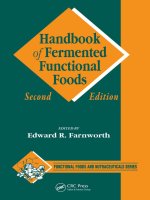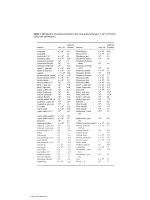handbook of fermented functional foods
Bạn đang xem bản rút gọn của tài liệu. Xem và tải ngay bản đầy đủ của tài liệu tại đây (6.9 MB, 602 trang )
Handbook
of Fermented
Functional
Foods
Second Edition
FUNCTIONAL FOODS AND NUTRACEUTICALS SERIES
Series Editor
G. Mazza, Ph.D.
Senior Research Scientist and Head
Food Research Program
Pacific Agri-Food Research Centre
Agriculture and Agri-Food Canada
Summerland, British Columbia
Methods of Analysis for Functional Foods and Nutraceuticals,
Second Edition
(2008)
Functional Food Carbohydrates
(2007)
Functional Food Ingredients and Nutraceuticals:
Processing Technologies
(2007)
Dictionary of Nutraceuticals and Functional Foods
(2006)
Handbook of Functional Lipids
(2006)
Handbook of Functional Dairy Products
(2004)
Handbook of Fermented Functional Foods, Second Edition
(2008)
Herbs, Botanicals, and Teas
(2002)
Functional Foods: Biochemical and Processing Aspects
Volume 2
(2002)
Functional Foods: Biochemical and Processing Aspects
Volume 1
(1998)
Edited by W. Jeffrey Hurst, Ph.D.
Costas G. Biliaderis, Ph.D. and Marta S. Izydorczyk, Ph.D.
John Shi, Ph.D.
N. A. Michael Eskin, Ph.D. and Snait Tamir, Ph.D.
Edited by Casimir C. Akoh, Ph.D.
Edited by Collete Short and John O’Brien
Edited by Edward R. Farnworth, Ph.D.
Edited by G. Mazza, Ph.D. and B.D. Oomah, Ph.D.
Edited by John Shi, Ph.D., G. Mazza, Ph.D., and Marc Le Maguer, Ph.D.
Edited by G. Mazza, Ph.D.
Handbook
of Fermented
Functional
Foods
Second Edition
EDITED BY
Edward R. Farnworth
Boca Raton London New York
CRC Press is an imprint of the
Taylor & Francis Group, an informa business
CRC Press
Taylor & Francis Group
6000 Broken Sound Parkway NW, Suite 300
Boca Raton, FL 33487-2742
© 2008 by Taylor & Francis Group, LLC
CRC Press is an imprint of Taylor & Francis Group, an Informa business
No claim to original U.S. Government works
Printed in the United States of America on acid-free paper
10 9 8 7 6 5 4 3 2 1
International Standard Book Number-13: 978-1-4200-5326-5 (Hardcover)
This book contains information obtained from authentic and highly regarded sources Reasonable efforts have been made to publish reliable data and information, but the author and publisher
cannot assume responsibility for the validity of all materials or the consequences of their use. The
Authors and Publishers have attempted to trace the copyright holders of all material reproduced
in this publication and apologize to copyright holders if permission to publish in this form has not
been obtained. If any copyright material has not been acknowledged please write and let us know so
we may rectify in any future reprint
Except as permitted under U.S. Copyright Law, no part of this book may be reprinted, reproduced,
transmitted, or utilized in any form by any electronic, mechanical, or other means, now known or
hereafter invented, including photocopying, microfilming, and recording, or in any information
storage or retrieval system, without written permission from the publishers.
For permission to photocopy or use material electronically from this work, please access www.
copyright.com ( or contact the Copyright Clearance Center, Inc. (CCC)
222 Rosewood Drive, Danvers, MA 01923, 978-750-8400. CCC is a not-for-profit organization that
provides licenses and registration for a variety of users. For organizations that have been granted a
photocopy license by the CCC, a separate system of payment has been arranged.
Trademark Notice: Product or corporate names may be trademarks or registered trademarks, and
are used only for identification and explanation without intent to infringe.
Visit the Taylor & Francis Web site at
and the CRC Press Web site at
Contents
Series Editor’s Preface...............................................................................................ix
Preface to Second Edition..........................................................................................xi
About the Author.................................................................................................... xiii
List of Contributors................................................................................................... xv
Chapter 1 The History of Fermented Foods.......................................................... 1
Jashbhai B. Prajapati and Baboo M. Nair
Chapter 2 Challenges Associated with the Development of ProbioticContaining Functional Foods..............................................................25
Niamh Kearney, Catherine Stanton, Colette Desmond, Mairead
Coakley, J. Kevin Collins, Gerald Fitzgerald, and R. Paul Ross
Chapter 3 The Properties of Enterococcus faecium and the Fermented
Milk Product—Gaio®......................................................................... 71
Marcelo Chiara Bertolami and Edward R. Farnworth
Chapter 4 Kefir—A Fermented Milk Product..................................................... 89
Edward R. Farnworth and Isabelle Mainville
Chapter 5 Yogurt and Immunity: The Health Benefits of Fermented Milk
Products That Contain Lactic Acid Bacteria.................................... 129
Judy Van de Water and Phornnop Naiyanetr
Chapter 6 Health Properties of Milk Fermented with Lactobacillus casei
strain Shirota (LcS)........................................................................... 165
Kouji Miyazaki and Takeshi Matsuzaki
Chapter 7 Biologically Active Peptides Released in Fermented Milk:
Role and Functions............................................................................209
Gabriel Vinderola, Alejandra de Moreno de LeBlanc, Gabriela
Perdigón, and Chantal Matar
v
vi
Handbook of Fermented Functional Foods, Second Edition
Chapter 8 Cheese and Its Potential as a Probiotic Food.................................... 243
Knut J. Heller, Wilhelm Bockelmann, Juergen Schrezenmeir,
and Michael deVrese
Chapter 9 Natto: A Soybean Food Made by Fermenting Cooked Soybeans
with Bacillus subtilis (natto)............................................................. 267
Tomohiro Hosoi and Kan Kiuchi
Chapter 10 Fermented Meat................................................................................ 291
Walter P. Hammes, Dirk Haller, and Michael G. Gänzle
Chapter 11 Miso: Production, Properties, and Benefits to Health....................... 321
Yukiko Minamiyama and Shigeru Okada
Chapter 12 Korean Fermented Foods: Kimchi and Doenjang............................ 333
Jeonghee Surh, Young-Kyung Lee Kim, and Hoonjeong Kwon
Chapter 13 Lactobacillus plantarum: The Role in Foods and in Human
Health................................................................................................ 353
Göran Molin
Chapter 14 Sauerkraut.......................................................................................... 395
Wilhelm Holzapfel, Ulrich Schillinger, and Herbert Buckenhüskes
Chapter 15 New Trends of Table Olive Processing for Quality Control
and Functional Proprieties................................................................ 413
Moktar Hamdi
Chapter 16 Traditional Chinese Fermented Foods.............................................. 433
Y-H. Peggy Hsieh, Steven Pao, and Jiangrong Li
Chapter 17 Tempeh: A Mold-Modified Indigenous Fermented Food................. 475
Daniel Y. C. Fung and Beth Ann Crozier-Dodson
Chapter 18 Thai Fermented Foods: Microorganisms and Their Health
Benefits.............................................................................................. 495
Somboon Tanasupawat and Wonnop Visessanguan
vii
Contents
Chapter 19 Production of Probiotic Cultures and Their Addition in
Fermented Foods............................................................................... 513
Claude P. Champagne and Henrik Møllgaard
Chapter 20 The Future for Fermented Foods...................................................... 533
Edward R. Farnworth
Index....................................................................................................................... 551
Series Editor’s Preface
The Functional Foods and Nutraceuticals Book Series, launched in 1998, was developed to provide a timely and comprehensive treatment of the emerging science and
technology of functional foods and nutraceuticals, which are shown to play a role
in preventing or delaying the onset of diseases, especially chronic diseases. The
first eleven volumes in the Series have received broad acceptance by food, nutrition,
and health professionals. They are: Functional Foods: Biochemical and Processing
Aspects. (Volumes 1 and 2), Herbs Botanicals and Teas, Methods of Analysis for
Functional Foods and Nutraceuticals (1st and 2nd Editions), Handbook of Fermented Functional Foods (1st Edition), Handbook of Functional Dairy Products,
Handbook of Functional Lipids, Dictionary of Functional Foods and Nutraceuticals, Processing Technologies for Functional Foods and Nutraceuticals, and Functional Food Carbohydrates.
The latest volume, Handbook of Fermented Functional Foods, 2nd Edition,
edited by Dr. Edward R. Farnworth (Agriculture and Agri-Food Canada, Saint Hyacinthe, Quebec, Canada) is organized into 20 chapters, contributed by 39 leading
scientists from 12 counties.
The second edition of this exceptional book on fermented functional foods provides updated, in-depth treatments of the scientific and technological information
on all the topics covered in the first edition (history of fermented foods; challenges
facing development of probiotic-containing functional foods; properties of Enterococcus faecium and fermented milk; kefir; yogurt and immunity; health properties
of milk fermented with Lactobacillus casei; biologically active peptides released in
fermented milk; cheese and its potential as a probiotic food; natto, a soybean food
made by fermenting cooked soybeans with Bacillus subtilis (natto); fermented meat;
miso production, properties and health benefits; Korean fermented foods, kimchi and
doenjang; the role of Lactobacillus Plantarum in foods and human health; sauerkraut; and the future for fermented foods), as well as five new chapters addressing
traditional Chinese fermented foods; tempeh or tempe kedelee, a mold-modified food
made by the fermentation of dehulled, cooked soybeans with Rhizopus oligosporus;
table olive processing for quality control and functional proprieties; Thai fermented
foods that include fermented fish, meat, and plant products; and production of probiotic cultures and their addition in fermented foods.
Dr. Farnworth has assembled a group of outstanding international contributors
in the forefront of fermented food science and technology, and together they have
produced an outstanding reference book that is expected to be a valuable resource for
researchers, teachers, students, food, nutrition and health practitioners, and all those
working in the functional food and nutraceutical industry.
To Dr. Farnworth and all the contributors I extend my sincere thanks, and I hope
that the reader will find this book informative and stimulating.
G. Mazza, Ph.D., FCIFST, FIAFoST
Series Editor
ix
Preface to Second Edition
The role of food in health and well-being is becoming more and more evident. At the
same time, our understanding of how the complex microbiota in the gastrointestinal
tract functions is expanding. Digestion, metabolism, diseases resistance—all appear
to be influenced by the bacteria that live in our gastrointestinal tracts (autochthonous
bacteria) and by live bacteria that we eat in our food (allochthonous bacteria). The
properties of each individual bacterial species often are unique; results from experiments using even closely related bacteria often are different. As a result, a consensus
of opinion about the beneficial effects of probiotics is hard to achieve.
We are seeing new fermented foods in the marketplace as the concept of probiotics is gaining credibility, and as food manufacturers find innovative ways to protect
bacteria in an ever wider variety of foods and beverages. As has been described in
the chapters of this book, people have been eating fermented foods around the world
for centuries. This continues today, and may be even more important in the future.
This second edition updates chapters that appeared in the first edition with new
findings and interpretations that point even more clearly to the important role fermented foods play in our diets. Additional chapters have been added that include
descriptions of additional fermented foods that are common in the diets of consumers around the world.
xi
About the Author
Dr. Edward (Ted ) Farnworth is a senior research scientist at the Agriculture and
Agri-food Canada Food Research Development Centre in St. Hyacinth, Quebec.
He received his Ph.D. in nutrition at the University of Guelph and since joining
AAFC has carried out research on the nutritional quality of canola oil, sow and
piglet nutrition, and most recently on functional foods and probiotics. Dr. Farnworth
is a past-president of the Canadian Society for Nutritional Sciences and currently
program leader for the Functional Foods and Nutraceuticals program at his center.
His publication list includes articles in chemistry, microbiology, food science, flavor
chemistry, and animal and human nutrition and metabolism. His team carries out
research on the composition (chemical, microbiological) of various fermented foods,
and using in vitro, animal models, and clinical trials, they are showing the efficacy
and mode of action of potential probiotics and prebiotics.
xiii
List of Contributors
Marcelo Chiara Bertolami
Instituto Dante Pazzanese de
Cardiologia
São Paulo
Brazil
Wilhelm Bockelmann
Institute for Microbiology
Federal Research Center for Nutrition
and Food
Kiel
Germany
Herbert Buckenhüskes
Gewürzmüller GmbH
Stuttgart
Germany
Claude Champagne
Food Research and Development Centre
Agriculture and Agri-food Canada
St. Hyacinthe, Quebec
Canada
Mairead Coakley
TEAGASC
Dairy Products Research Centre
Moorepark
Fermoy
County Cork
Ireland
J. Kevin Collins
Microbiology Department
University College–Cork
County Cork
Ireland
Beth Ann Crozier-Dodson
Department of Animal Science and
Industry and Food Science Institute
Kansas State University
Manhattan
Kansas
Alejandra de Moreno de LeBlanc
Centro de Referencia para Latobacilos
(CERELA-CONICET)
Chacabuco
San Miguel de Tucumán
Tucumán
Argentina
Colette Desmond
TEAGASC
Dairy Products Research Centre
Moorepark
Fermoy
County Cork
Ireland
Edward R. Farnworth
Food Research and Development Centre
Agriculture and Agri-food Canada
St. Hyacinthe, Quebec
Canada
Gerald Fitzgerald
Microbiology Department
University College–Cork
County Cork
Ireland
Daniel Y. C. Fung
Professor of Food Science
Kansas State University
Manhattan
Kansas
xv
xvi
Handbook of Fermented Functional Foods, Second Edition
Michael Gänzle
Department of Agricultural, Food and
Nutritional Science
University of Alberta
Edmonton
Canada
Dirk Haller
Technische Universität München
Zentralinnstitut für Ernährungs- und
Lebenmittelforschung (Ziel)
Immunbiologie der Ernährung
Wissenschaftszentrum
Weihenstephan
Germany
Moktar Hamdi
Laboratory of Microbial and Ecological
Technology
National Institute of Applied Sciences
and Technology
Department of Biological and Chemical
Engineering
Tunis
Tunisia
Walter P. Hammes
Institute of Food Technology
Hohenheim University
Stuttgart
Germany
Knut J. Heller
Institute for Microbiology
Federal Research Center for Nutrition
and Food
Kiel
Germany
Wilhelm Holzapfel
Institut für Hygiene und Toxikologie/
BFE
Karlsruhe
Germany
Tomohiro Hosoi
Tokyo Metropolitan Food Technology
Research Centre
Tokyo
Japan
Y-H. Peggy Hsieh
Department of Nutrition, Food and
Exercise Sciences
Florida State University
Tallahassee
Florida
Niamh Kearney
TEAGASC
Dairy Products Research Centre
Moore Park
Fermoy
Ireland
Young-Kyung Lee Kim
Research Institute of Home Ecology
Seoul National University
Seoul
Korea
Kan Kiuchi
Department of Food Science and Nutrition
Kyoritsu Women’s University
Tokyo
Japan
Hoonjeong Kwon
Food Toxicology Division
Department of Food and Nutrition
Seoul National University
Seoul
Korea
Jiangrong Li
Department of Food Science and
Technology
College of Food Science and
Biotechnology
Zhejiang Gongshang University
Hangzhou
Zhejiang
People’s Republic of China
xvii
List of Contributors
Isabelle Mainville
Food Research and Development Centre
Agriculture and Agrifood Canada
St. Hyacinthe, Quebec
Canada
Baboo M. Nair
Department of Applied Nutrition and
Food Chemistry
Lund University
Lund
Sweden
Chantal Matar
Department of Chemistry and
Biochemistry
Université de Moncton
Moncton
New Brunswick
Canada
Phornnop Naiyanetr
Division of Rheumatology, Allergy, and
Clinical Immunology
Department of Internal Medicine
University of California
Davis
California
Takeshi Matsuzaki
Yakult Central Institute for
Microbiological Research
Tokyo
Japan
Shigeru Okada
Department of Pathological Research
Graduate School of Medicine and
Dentistry
Okayama University
Okayama
Japan
Yukiko Minamiyama
First Department of Pathology
Okayama University Medical School
Okayama
Japan
Kouji Miyazaki
Yakult Central Institute for
Microbiological Research
Kunitachi
Tokyo
Japan
Göran Molin
Laboratory of Food Hygiene
Division of Food Technology
Lund University
Lund
Sweden
Henrik Møllgaard
Hansen Co.
Hørsholm
Denmark
Gabriela Perdigón
Facultad de Bioquimica, Quimica y
Farmacia
Argentina Centro de Referencias por
lactobacillos
Universidad Nacional de Tucuman
Tucuman
Argentina
Steven Pao
Department of Food Science and
Technology
College of Food Science and
Biotechnology
Zhejiang Gongshang University
Hangzhou
Zhejiang
People’s Republic of China
Jashbhai B. Prajapati
Dairy Microbiology Department
SMC College of Dairy Science
Gujarat Agricultural University
Anand
India
xviii
Handbook of Fermented Functional Foods, Second Edition
R. Paul Ross
TEAGASC
Dairy Products Research Centre
Moore Park
Fermoy
Ireland
Somboon Tanasupawat
Department of Microbiology, Faculty of
Pharmaceutical Sciences
Chulalongkorn University
Bangkok
Thailand
Ulrich Schillinger
Institute of Hygiene and Toxicology,
BFE
Karlsruhe
Germany
Judy Van de Water
Division of Rheumatology/Allergy
University of California–Davis
Davis
California
Juergen Schrezenmeir
Institute for Physiology and
Biochemistry of Nutrition
Federal Research Center for Nutrition
and Food
Kiel
Germany
Gabriel Vinderola
Facultad de Ingeniería Química
Instituto de Lactología Industrial
(UNL-CONICET)
Santa Fe
Argentina
Catherine Stanton
TEAGASC
Dairy Products Research Centre
Moore Park
Fermoy
Ireland
Jeonghee Surh
Department of Food and Nutrition
Kangwon National University
Samcheok
Gangwon
Korea
Wonnop Visessanguan
Food Biotechnology Laboratory
BIOTEC-Central Research Unit
National Center for Genetic
Engineering and Biotechnology
Klong Luang
Pathumthani
Thailand
Michael deVrese
Institute for Physiology and
Biochemistry of Nutrition
Federal Research Center for Nutrition
and Food
Kiel
Germany
History of
1 The
Fermented Foods
Jashbhai B. Prajapati and Baboo M. Nair
Contents
1.1
1.2
Introduction...................................................................................................... 2
Fermented Milks.............................................................................................. 3
1.2.1 Dahi....................................................................................................... 5
1.2.2 Kefir...................................................................................................... 6
1.2.3 Kumys................................................................................................... 6
1.2.4 Yogurt (Yoghurt)................................................................................... 6
1.2.5 Cheese................................................................................................... 7
1.3 Cereal- and Legume-Based Fermented Foods................................................. 9
1.3.1 Bread................................................................................................... 10
1.3.2 Idli....................................................................................................... 15
1.3.3 Dosa.................................................................................................... 17
1.3.4 Soy Foods............................................................................................ 17
1.3.4.1 Soy Sauce.............................................................................. 17
1.3.4.2 Miso....................................................................................... 17
1.3.4.3 Tempeh.................................................................................. 17
1.3.4.4 Natto...................................................................................... 18
1.3.4.5 Sufu....................................................................................... 18
1.4 Fermented Plant Root Products..................................................................... 18
1.4.1 Gari..................................................................................................... 18
1.4.2 Fufu..................................................................................................... 19
1.5 Fermented Fruits and Vegetables................................................................... 19
1.5.1 Sauerkraut........................................................................................... 19
1.5.2 Kimchi................................................................................................20
1.5.3 Pickled Vegetables..............................................................................20
1.5.4 Olives..................................................................................................20
1.6 Fermented Fish and Fish Products................................................................. 21
1.7 Fermented Meat Products.............................................................................. 21
Acknowledgment...................................................................................................... 22
References................................................................................................................. 22
1









